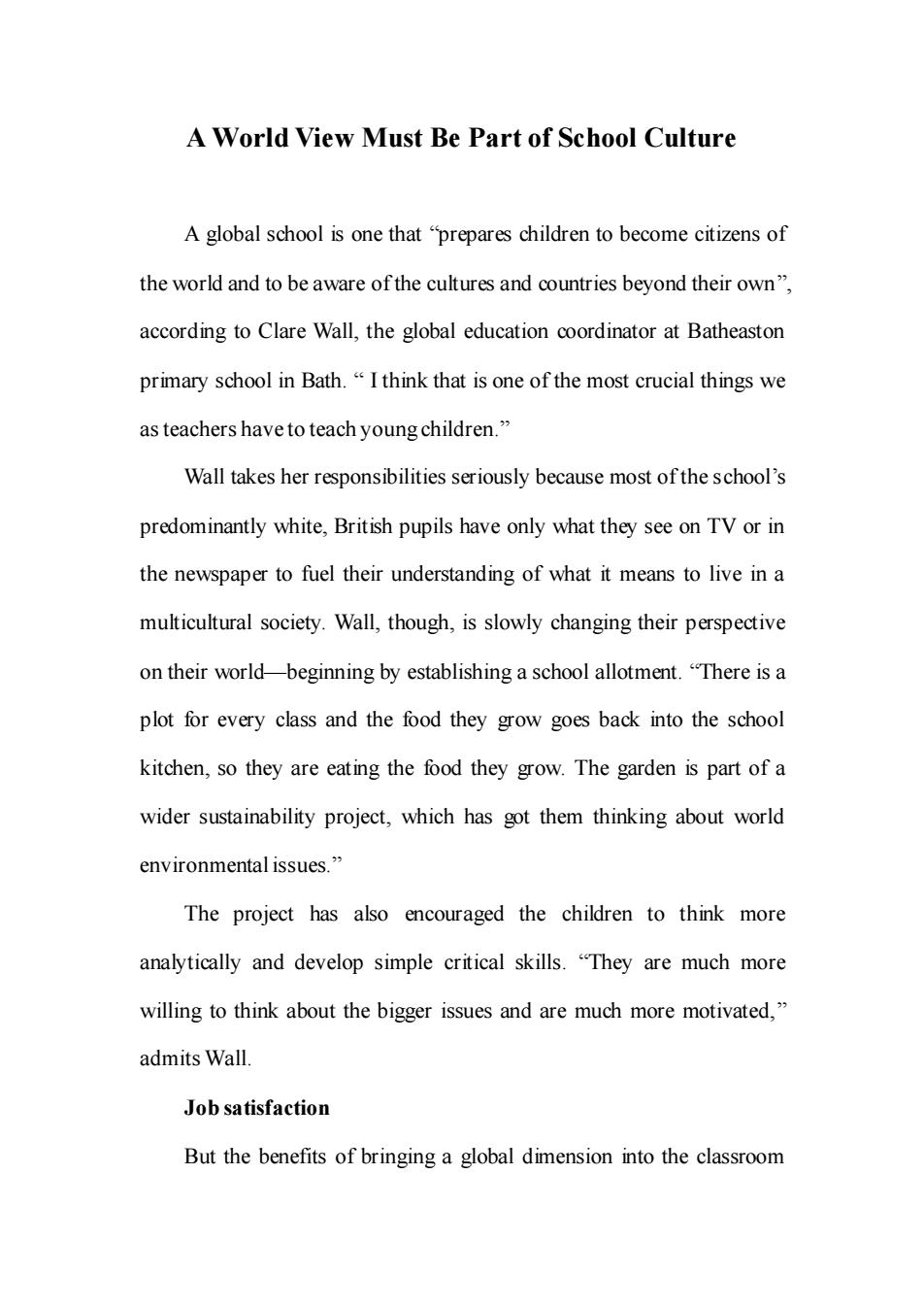
A World View Must Be Part of School Culture A global school is one that "prepares children to become citizens of the world and to be aware of the cultures and countries beyond their own", according to Clare Wall,the global education coordinator at Batheaston primary school in Bath."I think that is one of the most crucial things we as teachers have to teach young children." Wall takes her responsibilities seriously because most of the school's predominantly white,British pupils have only what they see on TV or in the newspaper to fuel their understanding of what it means to live in a multicultural society.Wall,though,is slowly changing their perspective on their world-beginning by establishing a school allotment."There is a plot for every class and the food they grow goes back into the school kitchen,so they are eating the food they grow.The garden is part of a wider sustainability project,which has got them thinking about world environmental issues." The project has also encouraged the children to think more analytically and develop simple critical skills."They are much more willing to think about the bigger issues and are much more motivated," admits Wall. Job satisfaction But the benefits of bringing a global dimension into the classroom
A World View Must Be Part of School Culture A global school is one that “prepares children to become citizens of the world and to be aware of the cultures and countries beyond their own”, according to Clare Wall, the global education coordinator at Batheaston primary school in Bath. “ I think that is one of the most crucial things we as teachers have to teach young children.” Wall takes her responsibilities seriously because most of the school’s predominantly white, British pupils have only what they see on TV or in the newspaper to fuel their understanding of what it means to live in a multicultural society. Wall, though, is slowly changing their perspective on their world—beginning by establishing a school allotment. “There is a plot for every class and the food they grow goes back into the school kitchen, so they are eating the food they grow. The garden is part of a wider sustainability project, which has got them thinking about world environmental issues.” The project has also encouraged the children to think more analytically and develop simple critical skills. “They are much more willing to think about the bigger issues and are much more motivated,” admits Wall. Job satisfaction But the benefits of bringing a global dimension into the classroom
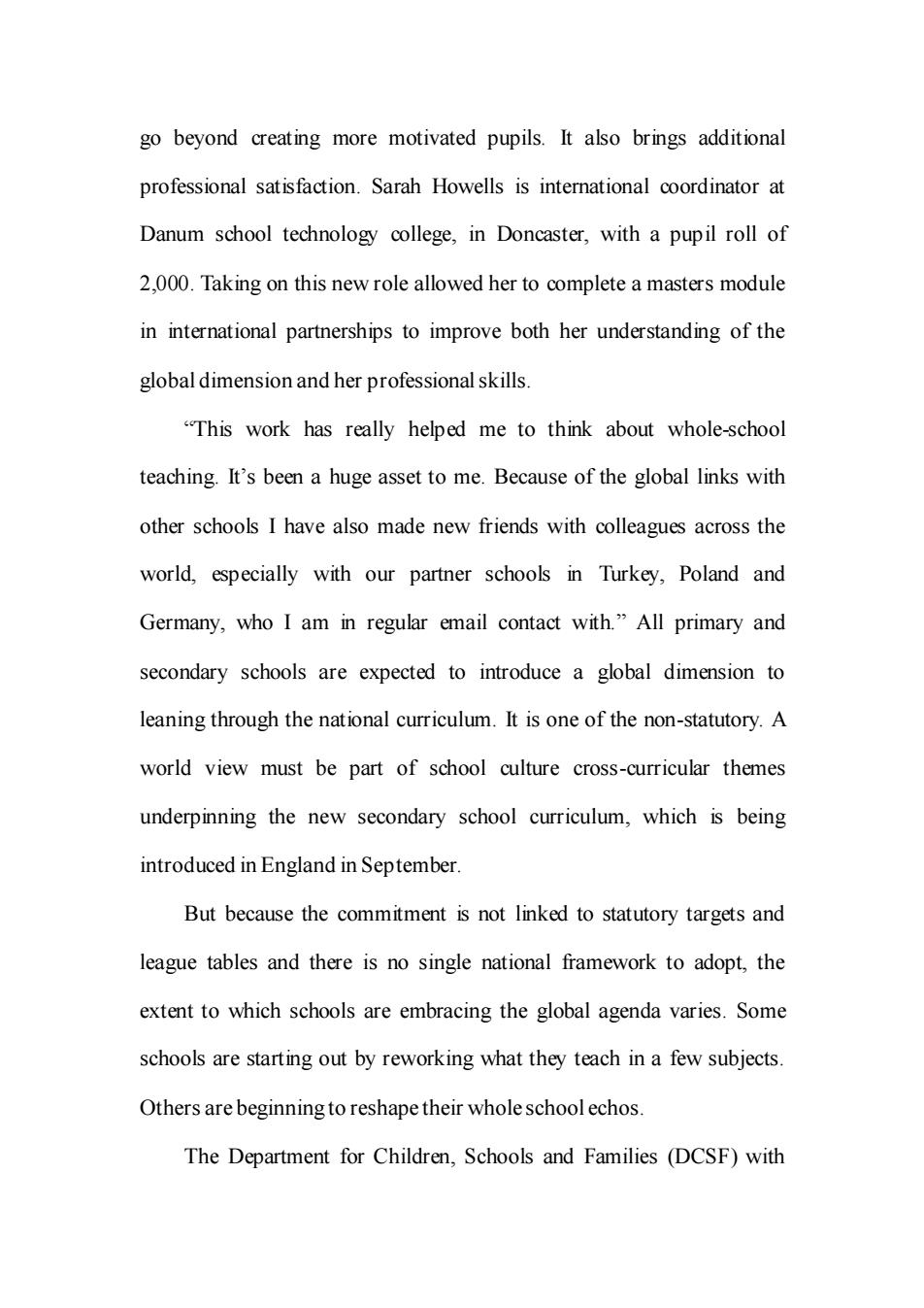
go beyond creating more motivated pupils.It also brings additional professional satisfaction.Sarah Howells is international coordinator at Danum school technology college,in Doncaster,with a pupil roll of 2,000.Taking on this new role allowed her to complete a masters module in international partnerships to improve both her understanding of the global dimension and her professional skills. "This work has really helped me to think about whole-school teaching.It's been a huge asset to me.Because of the global links with other schools I have also made new friends with colleagues across the world,especially with our partner schools in Turkey,Poland and Germany,who I am in regular email contact with."All primary and secondary schools are expected to introduce a global dimension to leaning through the national curriculum.It is one of the non-statutory.A world view must be part of school culture cross-curricular themes underpinning the new secondary school curriculum,which is being introduced in England in September. But because the commitment is not linked to statutory targets and league tables and there is no single national framework to adopt,the extent to which schools are embracing the global agenda varies.Some schools are starting out by reworking what they teach in a few subjects Others are beginning to reshape their whole school echos. The Department for Children,Schools and Families (DCSF)with
go beyond creating more motivated pupils. It also brings additional professional satisfaction. Sarah Howells is international coordinator at Danum school technology college, in Doncaster, with a pupil roll of 2,000. Taking on this new role allowed her to complete a masters module in international partnerships to improve both her understanding of the global dimension and her professional skills. “This work has really helped me to think about whole-school teaching. It’s been a huge asset to me. Because of the global links with other schools I have also made new friends with colleagues across the world, especially with our partner schools in Turkey, Poland and Germany, who I am in regular email contact with.” All primary and secondary schools are expected to introduce a global dimension to leaning through the national curriculum. It is one of the non-statutory. A world view must be part of school culture cross-curricular themes underpinning the new secondary school curriculum, which is being introduced in England in September. But because the commitment is not linked to statutory targets and league tables and there is no single national framework to adopt, the extent to which schools are embracing the global agenda varies. Some schools are starting out by reworking what they teach in a few subjects. Others are beginning to reshape their whole school echos. The Department for Children, Schools and Families (DCSF) with
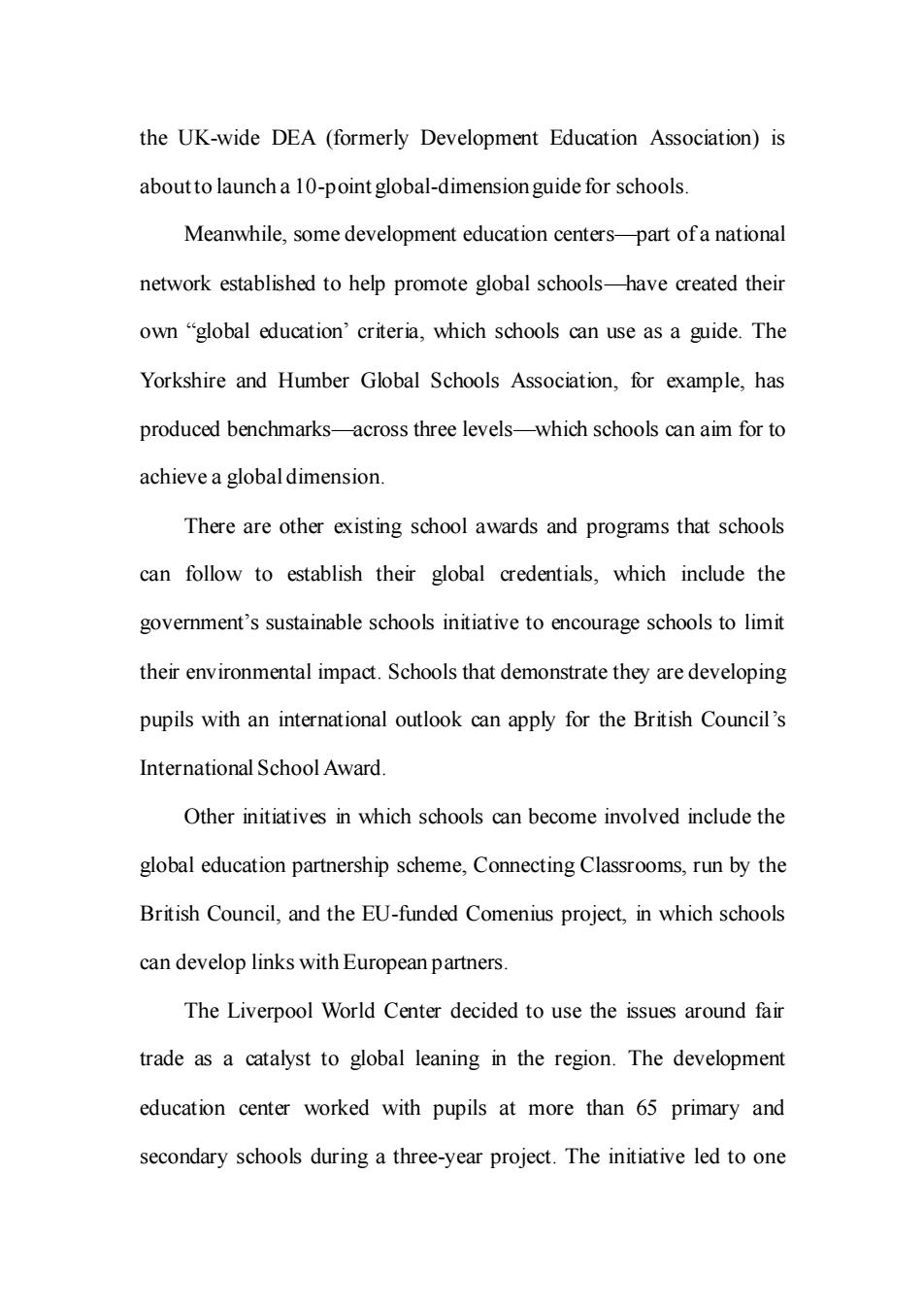
the UK-wide DEA (formerly Development Education Association)is about to launch a 10-point global-dimension guide for schools. Meanwhile,some development education centers-part ofa national network established to help promote global schools-have created their own "global education'criteria,which schools can use as a guide.The Yorkshire and Humber Global Schools Association,for example,has produced benchmarks-across three levels-which schools can aim for to achieve a global dimension. There are other existing school awards and programs that schools can follow to establish their global credentials,which include the government's sustainable schools initiative to encourage schools to limit their environmental impact.Schools that demonstrate they are developing pupils with an international outlook can apply for the British Council's International School Award. Other initiatives in which schools can become involved include the global education partnership scheme,Connecting Classrooms,run by the British Council,and the EU-funded Comenius project,in which schools can develop links with European partners. The Liverpool World Center decided to use the issues around fair trade as a catalyst to global leaning in the region.The development education center worked with pupils at more than 65 primary and secondary schools during a three-year project.The initiative led to one
the UK-wide DEA (formerly Development Education Association) is about to launch a 10-point global-dimension guide for schools. Meanwhile, some development education centers—part of a national network established to help promote global schools—have created their own “global education’ criteria, which schools can use as a guide. The Yorkshire and Humber Global Schools Association, for example, has produced benchmarks—across three levels—which schools can aim for to achieve a global dimension. There are other existing school awards and programs that schools can follow to establish their global credentials, which include the government’s sustainable schools initiative to encourage schools to limit their environmental impact. Schools that demonstrate they are developing pupils with an international outlook can apply for the British Council’s International School Award. Other initiatives in which schools can become involved include the global education partnership scheme, Connecting Classrooms, run by the British Council, and the EU-funded Comenius project, in which schools can develop links with European partners. The Liverpool World Center decided to use the issues around fair trade as a catalyst to global leaning in the region. The development education center worked with pupils at more than 65 primary and secondary schools during a three-year project. The initiative led to one
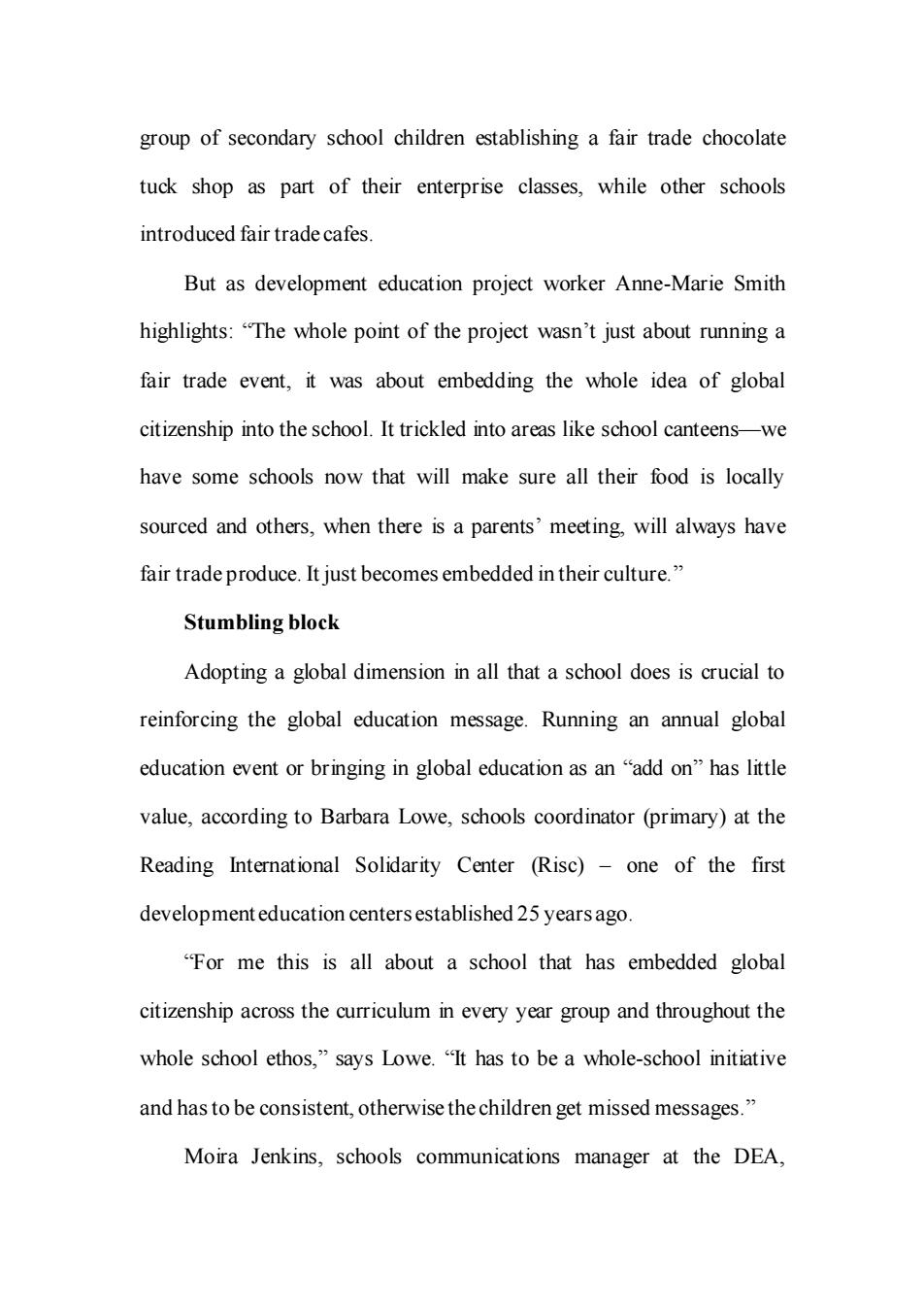
group of secondary school children establishing a fair trade chocolate tuck shop as part of their enterprise classes,while other schools introduced fair trade cafes. But as development education project worker Anne-Marie Smith highlights:"The whole point of the project wasn't just about running a fair trade event,it was about embedding the whole idea of global citizenship into the school.It trickled into areas like school canteens-we have some schools now that will make sure all their food is locally sourced and others,when there is a parents'meeting,will always have fair trade produce.It just becomes embedded intheir culture." Stumbling block Adopting a global dimension in all that a school does is crucial to reinforcing the global education message.Running an annual global education event or bringing in global education as an"add on"has little value,according to Barbara Lowe,schools coordinator (primary)at the Reading International Solidarity Center (Risc)-one of the first development education centersestablished25 yearsago "For me this is all about a school that has embedded global citizenship across the curriculum in every year group and throughout the whole school ethos,"says Lowe."It has to be a whole-school initiative and has to be consistent,otherwise the children get missed messages." Moira Jenkins,schools communications manager at the DEA
group of secondary school children establishing a fair trade chocolate tuck shop as part of their enterprise classes, while other schools introduced fair trade cafes. But as development education project worker Anne-Marie Smith highlights: “The whole point of the project wasn’t just about running a fair trade event, it was about embedding the whole idea of global citizenship into the school. It trickled into areas like school canteens—we have some schools now that will make sure all their food is locally sourced and others, when there is a parents’ meeting, will always have fair trade produce. It just becomes embedded in their culture.” Stumbling block Adopting a global dimension in all that a school does is crucial to reinforcing the global education message. Running an annual global education event or bringing in global education as an “add on” has little value, according to Barbara Lowe, schools coordinator (primary) at the Reading International Solidarity Center (Risc) – one of the first development education centers established 25 years ago. “For me this is all about a school that has embedded global citizenship across the curriculum in every year group and throughout the whole school ethos,” says Lowe. “It has to be a whole-school initiative and has to be consistent, otherwise the children get missed messages.” Moira Jenkins, schools communications manager at the DEA
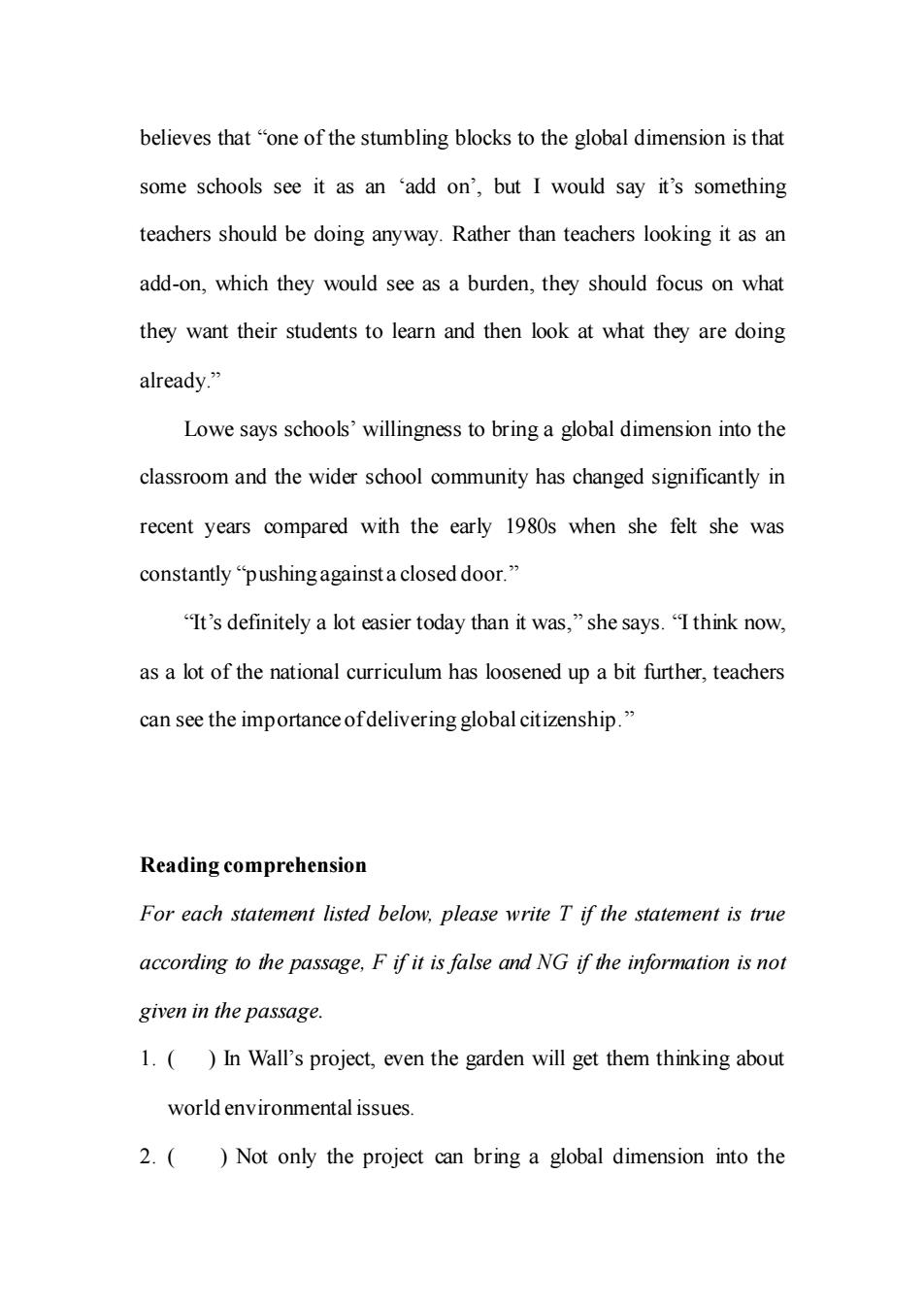
believes that"one of the stumbling blocks to the global dimension is that some schools see it as an 'add on',but I would say it's something teachers should be doing anyway.Rather than teachers looking it as an add-on,which they would see as a burden,they should focus on what they want their students to learn and then look at what they are doing already.” Lowe says schools'willingness to bring a global dimension into the classroom and the wider school community has changed significantly in recent years compared with the early 1980s when she felt she was constantly "pushing against a closed door. "It's definitely a lot easier today than it was,"she says."I think now, as a lot of the national curriculum has loosened up a bit further,teachers can see the importance ofdelivering global citizenship." Reading comprehension For each statement listed below.please write T if the statement is true according to the passage.F if it is false and NG if the information is not given in the passage. 1.()In Wall's project,even the garden will get them thinking about world environmental issues. 2.()Not only the project can bring a global dimension into the
believes that “one of the stumbling blocks to the global dimension is that some schools see it as an ‘add on’, but I would say it’s something teachers should be doing anyway. Rather than teachers looking it as an add-on, which they would see as a burden, they should focus on what they want their students to learn and then look at what they are doing already.” Lowe says schools’ willingness to bring a global dimension into the classroom and the wider school community has changed significantly in recent years compared with the early 1980s when she felt she was constantly “pushing against a closed door.” “It’s definitely a lot easier today than it was,” she says. “I think now, as a lot of the national curriculum has loosened up a bit further, teachers can see the importance of delivering global citizenship.” Reading comprehension For each statement listed below, please write T if the statement is true according to the passage, F if it is false and NG if the information is not given in the passage. 1. ( ) In Wall’s project, even the garden will get them thinking about world environmental issues. 2. ( ) Not only the project can bring a global dimension into the
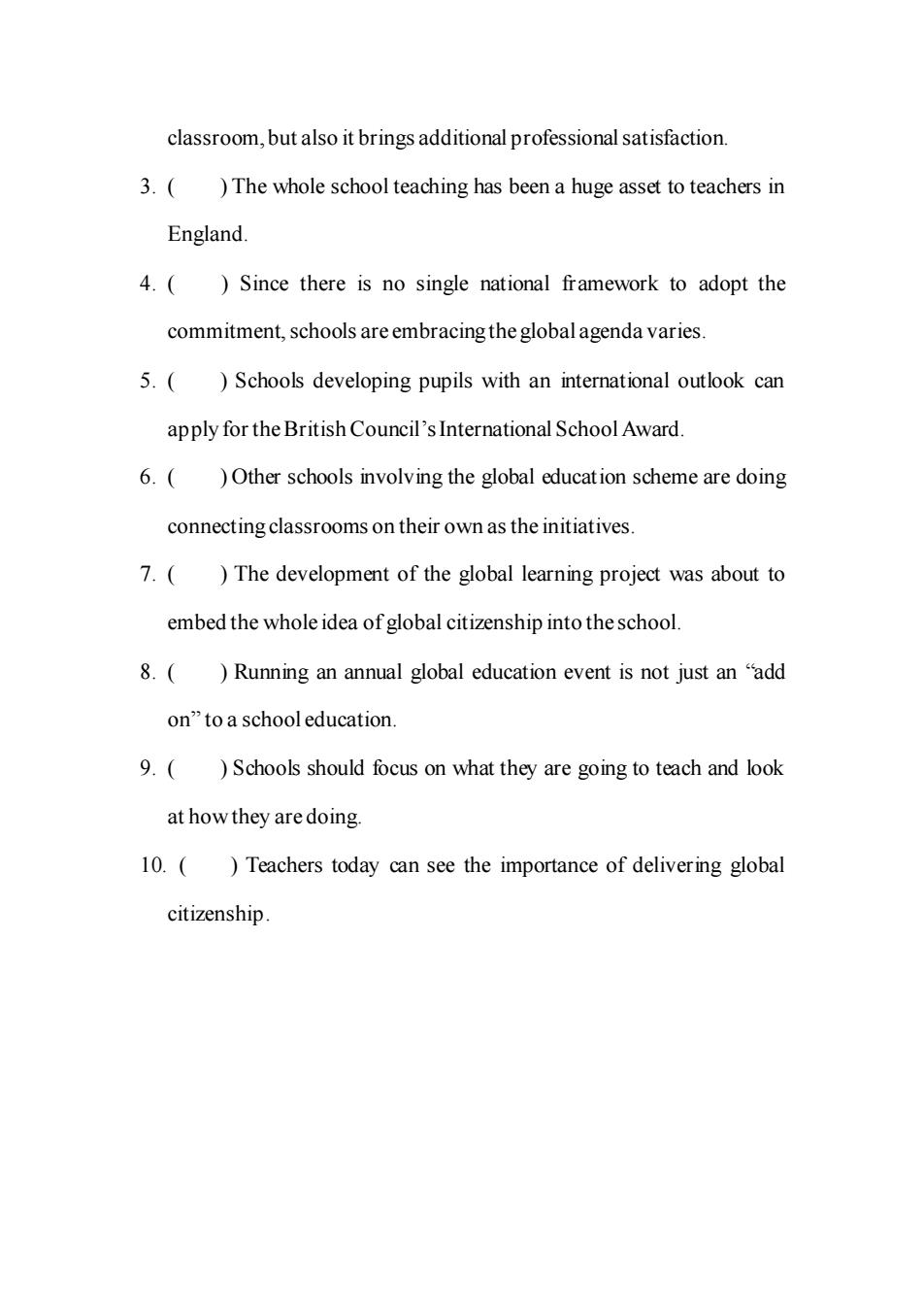
classroom,but also it brings additional professional satisfaction 3.)The whole school teaching has been a huge asset to teachers in England. 4.(Since there is no single national framework to adopt the commitment,schools are embracing the global agenda varies. 5.()Schools developing pupils with an international outlook can apply for the British Council's International School Award. 6.()Other schools involving the global education scheme are doing connecting classrooms on their own as the initiatives 7.()The development of the global learning project was about to embed the whole idea of global citizenship into the school. 8.()Running an annual global education event is not just an "add on"to a school education. 9.()Schools should focus on what they are going to teach and look at how they are doing. 10.(Teachers today can see the importance of delivering global citizenship
classroom, but also it brings additional professional satisfaction. 3. ( ) The whole school teaching has been a huge asset to teachers in England. 4. ( ) Since there is no single national framework to adopt the commitment, schools are embracing the global agenda varies. 5. ( ) Schools developing pupils with an international outlook can apply for the British Council’s International School Award. 6. ( ) Other schools involving the global education scheme are doing connecting classrooms on their own as the initiatives. 7. ( ) The development of the global learning project was about to embed the whole idea of global citizenship into the school. 8. ( ) Running an annual global education event is not just an “add on” to a school education. 9. ( ) Schools should focus on what they are going to teach and look at how they are doing. 10. ( ) Teachers today can see the importance of delivering global citizenship